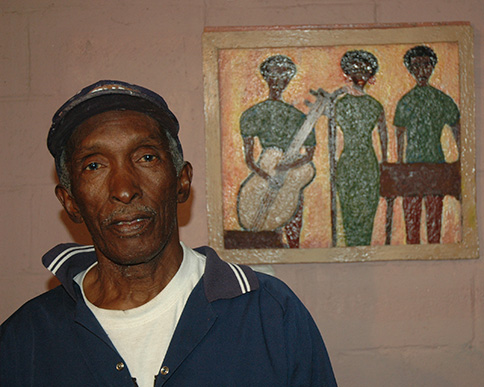
Lester Holt is known throughout northeastern Atmore for his handiwork with a hammer, a hoe or a hedge trimmer. But he has earned a wider degree of notoriety through his work with mud.
Holt, who is often called upon to make a neighbor’s or relative’s yard look nicer or to help build a deck or porch, is a regionally acclaimed “mud artist,” a designation that stems from his ability to turn red or white Alabama clay into works of folk art.
The local craftsman said the process of converting native dirt into landscapes, portraits or wildlife paintings is much like that employed by a baker.
“You have to get it like a batter,” he explained. “You have to keep on experimenting with it until you get to the point where you can sculpt with it. After you take the mud and crumble it up, you use a sifter to get all the rocks and stuff out of it. Then you add your ingredients, like sugar or Kool Aid, and work it into a batter that you can sculpt with.”
He said he uses a spray sealer to keep the mud from cracking as it dries. He then begins to slowly put the various pieces together to form his paintings.
“I do the background first, the sky or woods or grass or water, then I come on top of that with the person, animal or whatever,” he said. “You’ve got to be patient, especially on a painting that has people or animals in it.”
Holt was born in Evergreen but moved to Atmore with his family when he was still in grammar school. It was about that time that he realized he had a talent for drawing and painting.
“I started drawing when I was in the third grade,” he said. “I did it on my own, with no training. I just had the talent.”
Meeting the Mud Man
A few years later, he met the man who would lead him into a new avenue of artistic expression.
“I was in Fayette, Alabama, and I met this guy named Jimmy Lee Sudduth,” said Holt. “He did mud painting, and he was famous. He saw my paintings, and they were so much like his that he showed me how to go out in the woods and collect the white clay and red clay and how to put all the stuff together.”
Sudduth, who used blackberries, blueberries, reeds and other plants for the pigmentation in his paintings, died in 2007. He is regarded as one of the South’s premiere folk artists, and his creations can be seen in the Smithsonian National Museum of American Art, the American Museum of Folk Art, and in galleries around the world.
The local man hasn’t yet attained the same level of success. But his paintings do hang in galleries in Tuscaloosa, Bay Minette, Fairhope and elsewhere. He also regularly hawks his creations at Atmore’s Mayfest and Williams Station Day.
Holt, now 71, lives alone in the Harris Street home his mother left him. He said his paintings help him to combat the boredom that sometimes infiltrates a solitary life.
“I live by myself, and when I get bored, I have to stay busy,” he said. “Your mind can’t stay in one place, so you have to stay busy to fill the gaps. Sometimes, when I get an inspiration, I work all night. Whatever pops into my head, that’s what I work on. As I go, I create. A painting may change a bunch of times before I get through with it.”
Friend in a bottle
An accomplished clarinetist and saxophonist, Holt once fronted a jazz band, Lester & the L Tones, when he lived in New York. During that time, he learned to use liquor as a means of lessening the stress of playing all-night sessions in Long Island bars and honky-tonks.
He eventually became an alcoholic, but was able to break free from the bottle’s grasp through a new rehab program that was administered by Bill Wilson and Dr. Bob Smith, a program that would later become known as Alcoholics Anonymous. He eventually became a counselor, sharing his experiences with those fighting the same demon.
The mud artist, who said he hasn’t taken a drink of anything alcoholic since 1969, said his mud art also helps strengthen his resolve to maintain his sobriety.
“I got into alcohol real bad while I was up there in New York,” he admitted. “That’s another reason I do my work, to keep my mind occupied and keep my ‘friend’ away. When you’re busy, you don’t have negative thoughts. If I hadn’t did that (gone to rehab, then back to painting), that alcohol would have took me out of here.”



